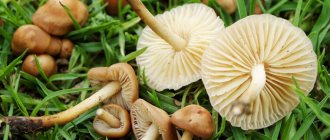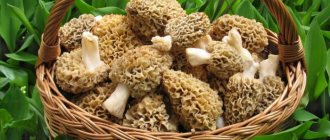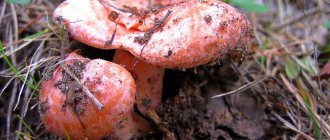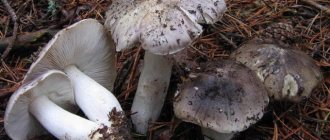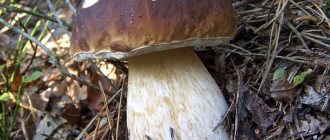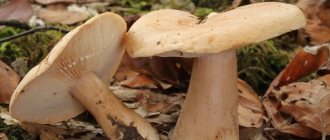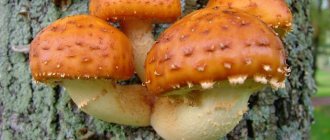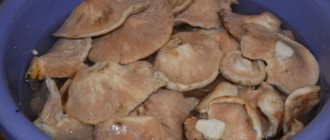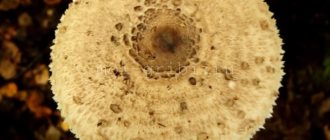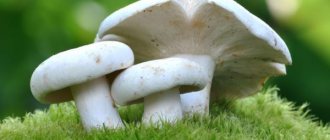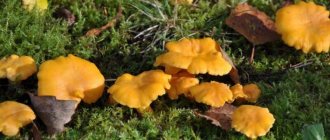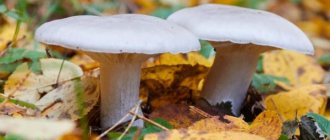General characteristics of the mushroom
Raincoat is popularly called differently: devil's apple, wolf's tobacco, hare's potato, powder. There are several species of this mushroom, most of which are edible. When eating puffballs for food, you must take into account that only young mushrooms with white and elastic flesh are suitable for this. When they age, the pulp becomes filled with spore powder, and the raincoat loses not only its beneficial properties, but also its taste.
The puffball belongs to the champignon family. This mushroom is characterized by the following external features:
- spherical or pear-shaped fruit body;
- dense skin, on which thorns are often observed;
- lack of separation into cap and stem;
- white and elastic flesh.
The mushroom ages very quickly. When this happens, the flesh turns yellow, loses its elasticity, and becomes sticky. Subsequently, it darkens, wrinkles and is filled with spore powder.
Photo and description of the pear-shaped puffball mushroom:
Puffball mushroom (Lycoperdon piroforme Skaeff).
Family: Puffballs (Lycoperdaceae).
Already at the very beginning of summer, after warm rains, these snow-white cotton balls appear on the warmed soil along the paths. As a rule, they do not arouse interest - someone will pass by indifferently, someone will kick them.
And by the name of this mushroom there is clearly no sense of respect; it is called “gypsy powder”, and “devil’s snuffbox”, and “grandfather’s tobacco”, and “lech’s egg”. But in vain. The fungus will give even boletus a head start in its nutritional and healing properties.
Firstly, it is absorbed by the body without much difficulty. Secondly, the healing properties of the raincoat are also known. In Belgium in the 18th century, weakened or consumptive patients were advised not to use chicken broth, as usual, but to use raincoat broth.
Young puffballs have an excellent ability to stop bleeding and disinfect a wound. If you don’t have iodine on hand when you have a cut at the dacha, pick off a raincoat ball, break it into two halves, apply it to the wound - and the blood will stop, and suppuration will not occur, the wound will heal quickly and without complications.
In its mature state, when the mushroom looks like an untidy ashtray, it does not lose its antiseptic properties. Its spores (that is, the contents of the sac) were applied to purulent and thrombophlebitis ulcers, and the wounds healed faster.
Raincoat tinctures were used for diseases of the blood and lymph. But the most interesting property of a raincoat is its ability to remove toxins from the body. Let's talk about this in more detail.
Mushrooms have one unique feature that is not very pleasant for mushroom pickers - the ability to absorb heavy metals, radioactive substances, and toxic volatile compounds. Indeed, if a chemical plant is located nearby, then the mushrooms in the forest will have the entire range of those elements that the plant produces.
This feature of mushrooms turned out to be extremely useful for environmental services. Mushrooms are now used... to clean the soil. For example, ten boletus mushrooms grown on radioactive soil clear a meter of such dirty area. But the most effective “cleaner” is a raincoat. It simply has no equal in terms of cleaning power.
This is interesting: What does kunja fish look like?
Doctors also became interested in this feature of mushrooms and conducted research. It turned out that mushroom powder behaves in the same way in the body: fungal cells suck in atoms of heavy metals and radionuclides like a vacuum cleaner.
Control tests were carried out: two groups of mice were put on a diet with a high dose of lead, a week later the second group was given a drug based on raincoat, the first group was on a regular diet. The very next day, lead was found in the excrement of the second group, traces of which were found for another 3 days. In the first group, lead was not found in the excrement, that is, it remained in the body.
This feature of raincoats was tried to remove fluorine and chlorine compounds from the body - and also with success.
This means that preventive use of raincoat medications will protect workers at chemical plants from occupational diseases such as sarcoidosis, fluorideosis, etc.
I think it is unnecessary to talk about zones of increased radiation in large cities, about zones of natural radiation (for example, in Murmansk and Severodvinsk), about contaminated zones after the Chernobyl accident - endocrine diseases speak about this: in almost all of these territories, the most common disease is diffuse toxic goiter. And not because there is a chronic lack of iodine in the diet, but because the accumulation of radionuclides in the body reorients the thyroid gland - it makes it forget how to absorb iodine.
The raincoat removes radionuclides remarkably well - much better than herbs (for example, juniper), precisely because of the peculiarities of the structured cell of the fungus - the difference in osmotic pressure forces the cell to suck up radionuclides, like a vacuum cleaner, and such a cell, like a string bag full of carrots, safely excreted in excrement.
And finally, the simplest use of a raincoat is to remove toxins after suffering helminthiases (that is, worms), hepatitis, kidney diseases, dysbacteriosis, precisely when the skin and hair suffer.
Description:
The fruit body is 3-7 cm high, 1-4 cm in diameter, ovoid, plum- or pear-shaped, white, gray or even brown, with a gradually darkening tubercle at the top, smooth or fine-grained, with a well-defined false stalk, which can be hidden in substrate. The pulp is pure white when young, and brownish-olive when mature. The spore powder is purple-brown.
The mushroom is found throughout the forest zone of Russia, except for the Far North. It grows in any type of forest, can grow on soil and litter, but especially prefers rotten wood. It develops massively in old clearings; it loves dead wood, rotten stumps, and the bases of trunks. Fruits from May to November.
Types of raincoats
Edible varieties of puffball are:
- Pear-shaped . The mushroom is small in size: up to 5.5 cm in length and width. As the name suggests, the shape of the fruiting body of the puffball resembles a pear. The outer layer is white, with cracks or scales on the surface.
- Spiky . This variety of puffball mushroom has a hemispherical fruiting body. The false leg stands out noticeably. A tubercle rises on the upper part. It also has small spikes that are easily separated from the surface of the cap. While the mushroom is young, its skin is white. As it matures, it becomes gray-brown.
- Gigantic . This type of raincoat is characterized by a spherical shape. When the mushroom ripens, its shell cracks. The color of the giant raincoat is white or gray-yellow. It is large in size and reaches up to 50 cm in width. The weight of such a mushroom can reach up to 7 kg.
- Brown (umber) . The puffball has the shape of a ball, its diameter is from 1 to 6 cm, and its height is up to 8 cm. When young, the mushroom is white in color, and as it matures it acquires brown tones. The cap of the brown raincoat has needle-like spikes.
Pear-shaped mushroom puffball
Spiny mushroom puffball
Giant mushroom puffball
Brown mushroom puffball
Also common are false puffballs, which are inedible. Unlike edible ones, false mushrooms of this type have a flattened round shape, gray or brownish color.
Inedible species
There are no poisonous mushrooms in the Lycoperdon family. But there are some that are unsuitable for food (bitter and difficult to digest). Deadly are the false puffballs, which look like puffballs but belong to a different family (Scleroderma fungi).
Scleroderma verrucosum
A small mushroom with a fruiting body 3–5 cm in diameter, wide at the top and narrow at the bottom. There is no pronounced stalk (it is no more than 0.6 cm long and is completely hidden in the soil). The surface is white-brown. The pulp is white with yellow longitudinal veins. The smell is pungent and quite unpleasant. The mushroom is cosmopolitan - that is, distributed everywhere. In Russia, it is most often found in oak forests in the Central and Central Black Earth regions.
Common puffball (Scleroderma citrinum)
The fruit body is up to 7 cm in diameter. The surface is white with brown spots. The flesh of young mushrooms is yellowish, while that of mature ones is gray or purple with large white fibers. Has an odor similar to rotting potatoes. It can be found in deciduous and coniferous forests, on clay and loamy soil. In Russia, it grows most in the European part and Western Siberia.
Spotted puffball (Scleroderma areolatum)
A pear-shaped mushroom of yellow color with brown spots. The surface is rough to the touch. When cut, coarse-fibrous greenish pulp with white veins is visible. Mature mushrooms crack when pressed, but do not generate dust with spores, like true raincoats. It grows on the soil in damp coniferous and deciduous forests, mainly settling on rotting stumps. Most often found in Central Russia, Eastern Europe and North America.
Bulbous puffball (Scleroderma cepa)
It has a cone-shaped fruiting body of dark yellow or brown color with slight spots on the surface. The base is narrowed and gathered into small folds. The pulp of young mushrooms is white, while that of mature ones is a gray or black mass. It grows in small groups on moist soil, under deciduous and coniferous trees and shrubs. These mushrooms are mainly found in deciduous forests, but can appear in gardens, parks, and along roadsides.
Star puffball (Scleroderma polyrhizum)
A round mushroom with a diameter of up to 15 cm. The young puffball has a spherical shape with a narrowed end. The surface is yellow with white fluff. When ripe, it darkens and opens its petals, revealing a dark brown cavity containing a black mass of round spores. Grows throughout Eurasia and North America in warm and humid conditions. It grows in groups of 3-7 mushrooms in deciduous and coniferous forests, on sandy and clay soil.
Enteridium lycoperdon
Distributed in central Russia. It usually grows on dry tree branches (it especially loves alder and elms), along the banks of rivers, streams and swamps. Has a round or irregular shape. When young, it is white in color, with a crystal-like surface. During the ripening period, the spores are darker, and the top is covered with a whitish fluff, reminiscent of mold. The cut reveals light flesh with large veins. The smell is quite unpleasant, reminiscent of rotten potatoes.
Stinking puffball (Lycoperdon montanum)
A yellow or brown mushroom with a wide fruiting body that tapers at the bottom. The top is covered with pointed spines, which, when pressed, easily fall to the ground. The height of the mushroom is up to 5 cm. The diameter at the widest part is up to 3 cm. When cut, it emits an unpleasant odor similar to gas. The pulp is yellow; when the mushroom ripens, it darkens and is replaced by brown spores. It is found throughout Eastern Europe and central Russia in coniferous and mixed forests.
Places and times of growth
The puffball mushroom is widespread on all continents, with the possible exception of Antarctica. It grows everywhere: you can find raincoat not only in the forest, but also in meadows, clearings, gardens, and along roads.
Some types of mushrooms can only be found in forests, some - in clearings and meadows.
Mushrooms collected along roads or near industrial enterprises should not be eaten: the raincoat has a special absorbent ability and actively absorbs various toxins.
Raincoats begin to grow in mid-May and do not disappear until October.
Raincoat composition
The puffball mushroom is valued in folk medicine due to its rich chemical composition. The fruiting bodies contain:
- iron, sodium and potassium;
- amino acids;
- iodine;
- fats;
- ergosterol;
- lipids;
- enzymes;
- calvacic acid;
- mineral salts;
- leucine and tyrosine;
- polysaccharides;
- antibiotic compounds;
- chitin.
The special value of the raincoat lies in the presence of a large amount of proteins in its composition. The mushroom is recommended to be consumed if there is a lack of meat in the diet.
Ways to grow raincoat at home
Various medicinal and cleansing agents are prepared from raincoats. This mushroom is also actively used in cooking. You can grow this mushroom at home and be confident in its purity and benefits.
To create a raincoat plantation at your summer cottage, you need to prepare mushroom mycelium. It can be purchased ready-made or a solution with spores can be prepared. To do this, finely chopped ripe raincoats are cut, placed in cold water and left for several days, stirring constantly. Water with fungal spores will become the basis for growing raincoats.
To plant mushrooms on the site, you should:
- Dig a trench 30 cm deep and 2 m wide. The area for planting raincoat mycelium should be in a dark place, under trees or a canopy.
- Pour the leaf mixture into the trench - poplar, aspen, birch leaves. Place tree branches on top, the leaves of which were placed in the ground earlier. This layer should be no more than 2 cm.
- Compact the layers tightly. The layer thickness should be 20 cm. Water it all with water.
- Sprinkle a 5 cm layer of soil on top.
- Pour the seed mycelium over the entire area into the trench, water it drip-wise, and cover it with branches.
The bed with the planted mycelium needs to be watered periodically. A slight excess of moisture in the ground is allowed.
When the bed is overgrown with mycelium, you should mulch it with leaves left over from last year.
You can expect the first harvest of raincoats a year after planting the mycelium.
Storage and preparation
After collection, place it in a cold place, so the mushroom will not lose its beneficial properties for 1-2 days. To increase shelf life, it can be frozen by cutting it into small pieces. It can remain in this form for up to 6 months.
When dried or salted, the shelf life increases to 12 months. Young representatives of this genus of mushrooms can be cooked without prior boiling.
Before frying, boil the puffballs for about 10 minutes. And when consumed boiled, for complete readiness, boil for at least 15 minutes.
You can prepare raincoats safely and tasty using various recipes. The main thing is to collect only young mushrooms, having previously cut the fruiting body to ensure the white flesh and edibility of this specimen.
Useful properties of a raincoat
The raincoat contains many useful substances. These are amino acids, enzymes, iron, potassium, iodine, sodium.
The ubiquitous raincoat has valuable beneficial properties. In particular, these mushrooms:
- absorb heavy metal salts, radionuclides and toxins, removing these dangerous compounds from the body;
- fight bacteria, pathogenic fungal microorganisms;
- have antitumor activity, suppress the growth of malignant tumors;
- have a positive effect on the functioning of the gastrointestinal tract;
- improve the functioning of the cardiovascular system;
- stop bleeding;
- fight kidney diseases;
- strengthen the immune system.
The fruiting body of the raincoat contains a natural antibiotic that suppresses the activity of the tuberculosis bacillus.
Healing properties of puffball mushroom
The puffball mushroom, whose medicinal properties are used by folk healers, is easily digestible, removes harmful substances from the body, and normalizes intestinal activity. These mushrooms contain a valuable substance - calvacin, which has an antitumor effect. It suppresses the growth of benign and malignant tumors.
Young mushrooms are used externally to stop bleeding. To do this, peeled and washed mushroom pulp is applied to the wound. Thanks to the antibacterial properties of the fungus, the wound heals quickly and does not become inflamed. The raincoat is also used in home cosmetology; masks made from it restore elasticity and healthy color to the skin.
The recipe for a medicinal tincture of raincoats is simple. To prepare it, you need to fill a half-liter jar of mushrooms with vodka and place it in a dark place for 3 weeks. Strain the prepared tincture, squeeze out the mushrooms and discard. Drink 1 tbsp. l. three times a day before meals.
Mushroom tincture is used to treat anemia, venous congestion, eczema and other diseases.
The mushroom is effective for the treatment of fibroids and thyroid diseases.
With the help of its extract, toxins are removed from the body in case of hepatitis and kidney diseases. A raincoat helps quickly cure intestinal disorders.
Methods of using mushrooms in cooking
Young puffballs collected in uncontaminated areas can be eaten. These mushrooms can be fried, stewed, baked, pickled and salted, and also added to various dishes.
A young raincoat does not require pre-cooking: if you do this, the cooking time with it will only be delayed. To prepare the raincoats, just peel them and cut the flesh into pieces of the desired size.
The following dishes can be prepared from these mushrooms:
- Mushrooms with sauce. Prepared mushrooms should be rolled in flour and lightly salted, and fried in vegetable oil until tender. To make the dish more original, you can add sauce to it. To prepare it, you need to take 2 bell peppers, chop them finely, add chopped capers, pickled cucumbers and green onions. Add mayonnaise, fresh lemon juice and a little soy sauce.
- Dried mushrooms. Peel the mushrooms, remove the hard skin. Cut into several pieces if the mushrooms are large. Raincoats should be dried by laying them out in the sun. They can also be dried in the oven or over the stove, strung on threads. Use dried mushrooms as additives. The soup works especially well with dry puffballs.
- Mushrooms in sour cream. To prepare a dish with a delicate taste, you need to take 500 g of young raincoats, 200 g of sour cream, 300 g of potatoes and 2 onions. Potatoes need to be peeled and boiled in salted water. Wash and peel the mushrooms, fry in oil for 25 minutes. Peel and chop the onion, fry separately. Combine mushrooms and onions, add salt and ground black pepper, fry for another 15 minutes. Add sour cream 5 minutes before the mushrooms are ready. Mix everything thoroughly again and let the ingredients simmer over low heat.
The collected raincoats need to be prepared as soon as possible - they, like other types of mushrooms, are not easy to keep.
Raincoat mushroom: how to cook for the winter?
pickled puffball mushrooms in a jar
Depending on your preferences, prepare a raincoat for storage until winter:
- dried
- marinated
In the first case:
- remove the skin and cut into slices
- boil or fry lightly
- fold on a horizontal surface and dry in any way convenient for you
- store in a ventilated area and container
In the second case you need:
- 1 kg raincoats
- 1 tablespoon each sugar and salt
- 5 tablespoons vinegar
- a couple of dill umbrellas
- a pair of garlic cloves
- 6 allspice peas
Cooking:
- peel the skins off the mushrooms and boil for a few minutes in boiling water
- add all the spices to the container and simmer them with the mushrooms for 10-15 minutes
- put the finished raincoats into jars
- pour marinade and seal with lids
- After a day, take it to the basement for storage.
Use of a raincoat for medicinal purposes
Various medicinal products can also be prepared using mushrooms. The most common traditional medicine recipes are:
- Tincture. To prepare, you need to take enough raincoats so that they half fill a half-liter bottle. Fill the remaining volume of the container with vodka. The product must be infused for 40 days. Take a teaspoon of the product before going to bed. Tincture on raincoats helps well with diseases of the kidneys, liver, and stomach. Alcohol tincture of mushrooms is also used to treat cancer.
- Powder. Raincoats need to be dried in the sun, then ground into powder. The resulting product is used to disinfect open wounds. It is enough to sprinkle it on problem areas. The powder from raincoats can also be used to treat a runny nose by gently sucking it into the nostrils.
- A product for external use for skin diseases. To prepare it, you need to take vodka and plain water in a 1:1 ratio and mix. Pour the resulting liquid into a container (for example, a 1 liter jar) filled with mushrooms. Raincoats must be compacted tightly; their structure must collapse. The product should be infused in a dark, cool place for 14 days, after which you need to add 10 drops of lavender or tea tree essential oil.
Before you start preparing medicinal compositions, you need to carefully sort out the mushrooms and make sure that there are no false puffballs among them.
What can you cook from puffball mushroom now: recipes
delicious ready-made dish with fried mushrooms
The fastest way is to fry its slices in batter or breadcrumbs. Dough for pancakes or pancakes is suitable as a batter.
Or cook mushroom soup.
a bowl of raincoat mushroom soup
You need:
- container with a volume of at least 4 liters
- 0.4 kg raincoats
- 3 liters chicken or vegetable broth
- potatoes, onions, carrots, dill, parsley, vermicelli - the amount you are used to
- vegetable oil or butter for frying
- salt pepper
Cooking:
- boil the broth and add chopped mushrooms
- after 5 minutes add potatoes and carrots
- At the same time, melt the butter in a frying pan and lightly fry the finely chopped onion
- catch the mushrooms and add them to the frying pan with the onions
- after 5 minutes, pour the contents of the frying pan into the boiling broth with vegetables
- add vermicelli and spices
- after 5 minutes, turn off the heating under the pan
- leave the soup to steep
- serve with finely chopped greens
Another recipe for fried puffballs.
stacked puffball mushrooms in a frying pan with chopped onions
You need:
- washed and peeled mushrooms
- a couple of small onions
- frying oil
- water
- 2 yolks
- 50 ml sour cream
- handful of flour
- salt, ground pepper, herbs - to taste
- 1 teaspoon fresh lemon juice
Cooking:
- Boil mushrooms in boiling salted water for a quarter of an hour
- throw them in a colander
- place in a saucepan along with the peeled onions
- add oil and fry until half the liquid has evaporated
- take out the onion
- sprinkle the mushrooms with flour, stir, continue frying for another third of an hour
- pour in the sour cream-yolk mixture
- then add chopped herbs, pepper, lemon juice
- mix thoroughly, reduce heat to low and simmer for 5-10 minutes
So, we looked at the differences between false and edible puffball mushrooms, learned how to prepare them for future use and immediately to the table.
Autumn is a generous time. Now she has already come into her own, so it’s time to get together with the family, arm yourself with baskets and go in search of mushrooms.
Happy hunting!
Contraindications
Raincoat is not recommended for use as food, or as a raw material for the preparation of medicinal formulations in case of intolerance to the components that make up it, as well as during pregnancy and lactation, under the age of 7 years.
It is not recommended to eat raincoat for those who suffer from severe kidney pathologies.
The puffball mushroom is ubiquitous. It can be found not only in forests, but also in clearings, as well as along roads. When collecting these mushrooms, you need to be able to distinguish edible ones from false ones. You can use raincoats to prepare various dishes, as well as medicinal compositions.
0
0
Copy link
conclusions
Despite the fact that many claim that these mushrooms are inedible, this is not true. Young, white raincoats have a pleasant taste, and during the cooking process they give off the smell of wood, which eventually disappears.
In addition, it is endowed with a number of healing properties. Both young and mature mushrooms are used to prepare medicines. A decoction, soup, and medicine are made from it.
It’s worth taking a closer look at the seemingly ordinary raincoat.
How to distinguish edible puffballs from their poisonous counterparts?
The inedible mushroom has a similar shape in appearance, but is distinguished by a warty and scaly dense shell, which may be covered with small cracks of a yellowish or pale brown hue. Its pulp is very dense, while edible mushrooms have a delicate structure, similar to marshmallows.
The smell of the raincoat is subtle and pleasant; the false raincoat smells like raw potatoes. In cross-section, the young inedible mushroom is white, just like the edible one, but you can see a small marble pattern with light veins.
There is an inedible mushroom called hedgehog puffball that is visually similar to the brown one. You can distinguish the double by the spines that cover the entire body of the mushroom, making it look like a hedgehog, as shown in the photo below. It is impossible to remove the sharp thorns, so you definitely won’t be able to cook it.
Beneficial nutritional properties and restrictions on consumption
Dust plants are highly valued in traditional medicine. They are able to absorb heavy metals, radioactive substances, fluorides, chlorides and remove them from the human body naturally. In addition, they prevent the development of cancerous tumors.
Edible puffballs that grow far from highways and industrial plants are not harmful to health. However, children and adolescents, women during lactation and pregnancy, and people in very old age should refrain from using them. In addition, dust pollen is difficult to digest, so people with gastrointestinal and kidney diseases should consume them in limited quantities.
Contraindications and possible harm
The benefits and harms of a raincoat are combined with each other. In some cases, eating the mushroom and using medicines based on it is prohibited. It is necessary to avoid using a dust bag:
- during pregnancy and during breastfeeding;
- for individual allergies;
- for severe liver diseases;
- with renal failure.
You should use the pulp of the dust pollen with caution if you have sluggish digestion and a tendency to constipation; it contains chitin, which is not absorbed by the intestines.
The puffball mushroom is not offered for food or treatment to children under seven years of age.
When collecting medicinal raw materials, it is important not to confuse puffballs with inedible false mushrooms. They can usually be distinguished by their gray or brown color and strongly flattened shape. Before collecting dust moths, you need to carefully study their photographs and put in the basket only those fruiting bodies whose species identity is beyond doubt.
Puffball can cause harm if it grows in an environmentally unfavorable area. For food and medicinal use, mushrooms must be collected away from roads, plants and factories. Fruiting bodies absorb all toxic substances from the soil and can pose a great danger.
